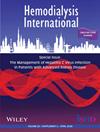Obesity and survival in a national cohort of incident hemodialysis patients: An analysis of the Brazilian Dialysis Registry
Abstract
Introduction
A phenomenon called the “obesity paradox” has consistently been reported in several cohorts of patients on chronic hemodialysis. In this setting, a higher body mass index (BMI) is paradoxically associated with better survival. This study aimed to evaluate the effect of BMI on mortality in patients undergoing chronic hemodialysis using the Brazilian Dialysis Registry.
Methods
This was a retrospective national cohort study with data on incident hemodialysis patients collected between January 2011 to December 2018. Those aged <18 or > 80 years were excluded from the study. The variables studied were the clinical and laboratory data regularly collected at the dialysis units. The variable of primary interest was BMI, represented as the median of the entire dialysis treatment and stratified into four ranges according to the World Health Organization (WHO) classification. The primary outcome was death within 4 years. Cox proportional hazards regression analysis was used to test associations with mortality.
Findings
The analyzed sample consisted of 5489 patients from 73 centers in five regions of the country. Of these, 5.9% were underweight, 48.3% were of normal weight, 31.0% were overweight, and 14.7% were obese. The 4-year survival rates in these BMI ranges were 58%, 70%, 75%, and 80%, respectively. The probability of survival for each BMI extract was significantly different from that in the normal-weight range (p < 0.05). In the fully adjusted Cox proportional hazard regression model, BMI > 24.9 kg/m2 remained an independent protective factor for mortality (HR: 0.76, 95% CI: 0.62–0.95, p = 0.016).
Discussion
In Brazil, being overweight and obese are protective factors for survival in the chronic hemodialysis population.

 求助内容:
求助内容: 应助结果提醒方式:
应助结果提醒方式:


